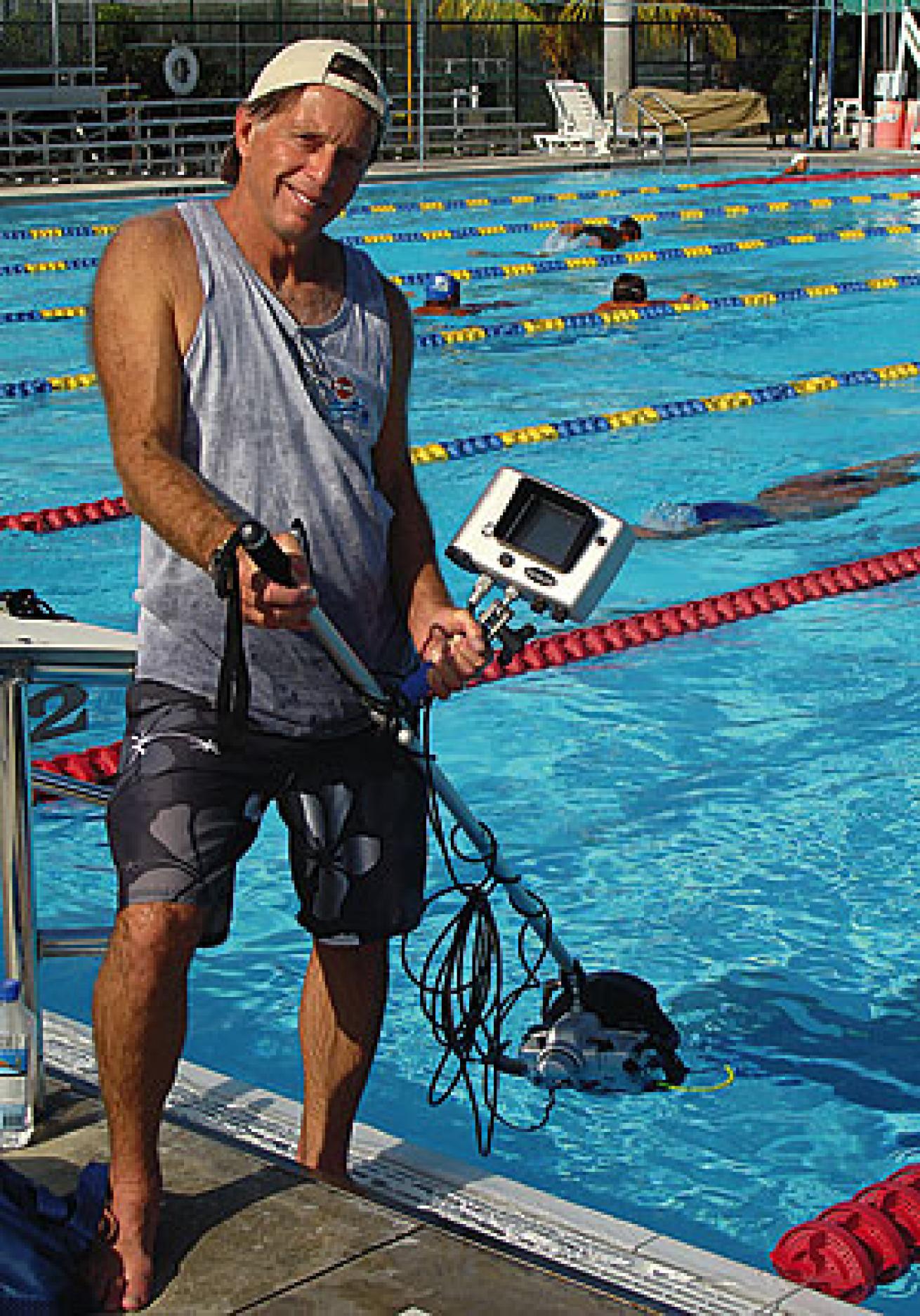Lucky Shots

Text and Photography by Stephen Frink
Underwater photography is a bit of a numbers game. It takes a lot of time in the water to experience really extraordinary photo opportunities. Granted, you have to go where the photo opportunities are. That's a huge contributor to success. Then you have to have the cameras, strobes and housings capable of capturing the image. But it's hard to buy your way into imaging immortality. You still need the skill to freeze that moment in time. Yet, even with all of this working in your favor, it never hurts to have a bit of luck as well.
I like to believe luck is the least important component, and that good planning and inspired execution can make luck happen. But sometimes, pure dumb luck makes all the difference. The first time I ever saw a whale shark was in Cocos Island, and then only because I was seated on the starboard side of the dinghy. Those of us on that side rolled over, cleared our masks and ended up looking seaward, directly at a whale shark 10 feet away. Those on the port side of the dinghy (including my wife, who wondered why she never saw me again on that dive) saw only the wall of the island we were meant to dive. Sometimes luck makes all the difference, but only to those prepared to capitalize. The following images are some of the most popular I've pulled off over the years. All required substantial practice and preparation ahead of time, but a little luck helped make them best sellers. Here are the stories and the setups behind four of my best shots:
Leaping Dolphins
Probably the single image that I'm most often asked about is my "leaping dolphins" shot taken off Roatan, Honduras. Questions about this photo are often accompanied by a knowing wink/nudge suggesting it's some clever Photoshop composite. I'd like to be a talented enough Photoshop artist to pull this off, but unfortunately, I'm not. Instead, it was the efforts of two nights' work, collaboration with the brilliant dolphin trainers at Anthony's Key Resort and more than a little luck.
AKR's dolphins regularly go to sea for open-water encounters with visiting scuba divers. They traverse a very scenic waterway separating Anthony's Key and Bailey's Key, shown here in the background. The image I saw in my mind's eye was the dolphins leaping out of the water, silhouetted in front of the setting sun. The technical challenge was that the sun caused glare on the water that made it very difficult to see the dolphins below the surface and predict where they would jump. The dolphin trainers could motivate the jump, but my job--focus and compose the image in a fleeting moment--was quite challenging. And remember, this was the film era, so I couldn't do a digital test exposure of the sunset to make sure it was dialed in before the action peaked. Plus, the trainers could only coax the dolphins to do this series of jumps a couple of times, particularly at the end of their day, and then only in the winter when the sun set early enough to not disrupt their schedule.
So, with all those variables, it wasn't much of a surprise that the first night we tried was full of fits and false starts. But by the second night, I had a sense of the rhythm of the jumps. I predicted where they would come out of the water, prefocused on the spot, and with my Nikon F100 camera set at 1/500th second and my continuous motor-drive on, I shot a series as they burst through the water and into the air. Even then, I didn't know I got the shot until I got home and processed the Fujichrome Velvia in my E-6 darkroom. Once the roll of 36 came out of the stabilizer and I was hanging it to dry, I saw this particular frame, and even without a loupe I knew this was the one. Samir Galindo of AKR tells me he gets pro shooters on location quite often who want to replicate this shot, but no one has ever gotten the two dolphins jumping toward each other. I've tried to do it again myself on later trips and could never get the same synergy of posture relative to the setting sun. I guess I'll have to be happy with this one.
Captain Slate's Barracuda
This year, 2008, marks Capt. Spencer Slate's 30-year anniversary in Key Largo, running dive trips from his Atlantis Dive Center. I know this well because we came to town at almost the same time, and in those early years, I was a frequent guest on his dive boats as I built my image archive. One of the things I loved to shoot was his weekly "Creature Feature," where he'd go out to the City of Washington wreck, and in just 25 feet of water (plenty of light and plenty of time), he'd eccentrically feed the green moray eels and barracuda by inviting them to take a dead ballyhoo from his clenched teeth.
This barracuda in particular was a tough subject to shoot. These fish move very fast when they hit the bait, they are extremely reflective and there are a lot of other fish competing for the same piece of food. It all becomes frenetic and gets stirred up quickly, but Slate has a wonderful instinct for driving the action to my dome and, after repeated sessions, we knew each other's rhythms well. Slate would look at me to make sure my strobe was in position and I was ready. With a tiny nod of my head to acknowledge, he'd raise the ballyhoo to his lips, sheltering it from the swarming yellowtail until the barracuda was in striking range. Actually, I found if I got very close to the bite, the yellowtail wouldn't get in front of my lens because if they got too close to the strike, they might get eaten as well. So, I moved in ultra-close with a 180-degree lens, in this case a 13mm on a Nikonos RS. I was probably about 7 inches from the teeth of the barracuda. Slate was much closer, and even after all these years, he still has both lips.
Great White Shark
There is no more impressive predator in the sea than the great white shark, and the quest for the classic shot of jaws agape and perfectly serrated teeth displayed has taken me to the three global hot spots for white sharking: Guadalupe, South Africa and South Australia. Usually, I'll shoot from behind the bars of a cage, but with the right shark and calm surface conditions, sometimes I can do better with a pole-mounted camera.
These days I have a very sophisticated polecam system (bottom right), with a tiny video camera replacing my optical viewfinder and feeding everything my lens sees to an external monitor, triggered by a remote control shutter release--all high-res digital, of course--but for this shot, back in the film days, my system was still pretty crude. We were at North Neptune Island, Australia, on the Calypso Star, and I had a Nikonos RS with a 13mm lens mounted at the end of the center section of my tripod. I had manually prefocused on the bait a foot away and the exposure was set to shutter speed priority--1/250th of a second to stop the action. Nikon's remote trigger release was used to take the shot, but the composition was random. Because of refraction, I couldn't tell exactly what the lens was seeing. My only hope was to get very close and fill the frame. At that point all I needed was a shark, near and gnarly, and fortunately this one obliged--for one pass only.
Grunt "Kiss"
Living in Key Largo, I get plenty of opportunities to photograph the ubiquitous blue-striped grunt, but with familiarity comes the challenge to capture the image differently or better than before. My favorite place to do so is a site called Snapper Ledge, not only for its massive populations of grunts, snapper and goatfish but also because of the unique behaviors that seem to go on there more commonly than at other sites. Here, the porkfish and four-eyed butterflyfish often approach the grunts, which in turn open their mouths wide for a cleaning.
I found the best tool for this action is a 100mm macro lens mounted on my full-frame digital SLR. By tracking the cleaner fish as they move into the school of grunts, it is not unusual to see one open its mouth. The trick is to have the strobes positioned and aperture set perfectly before entering the shoot zone. When the mouth opens, it won't be for long. Anticipating where the action will happen assures success.
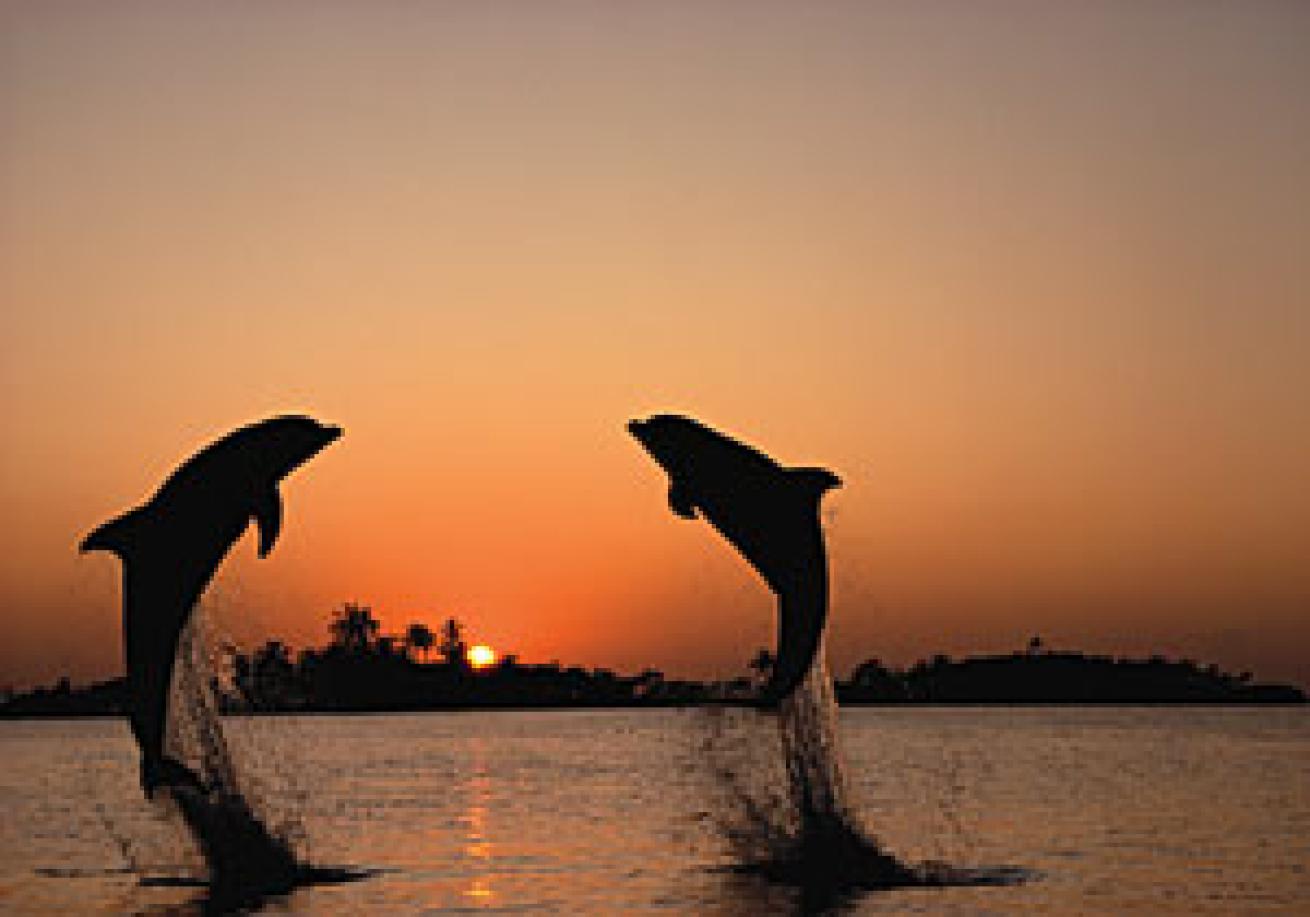
Text and Photography by Stephen Frink
Underwater photography is a bit of a numbers game. It takes a lot of time in the water to experience really extraordinary photo opportunities. Granted, you have to go where the photo opportunities are. That's a huge contributor to success. Then you have to have the cameras, strobes and housings capable of capturing the image. But it's hard to buy your way into imaging immortality. You still need the skill to freeze that moment in time. Yet, even with all of this working in your favor, it never hurts to have a bit of luck as well.
I like to believe luck is the least important component, and that good planning and inspired execution can make luck happen. But sometimes, pure dumb luck makes all the difference. The first time I ever saw a whale shark was in Cocos Island, and then only because I was seated on the starboard side of the dinghy. Those of us on that side rolled over, cleared our masks and ended up looking seaward, directly at a whale shark 10 feet away. Those on the port side of the dinghy (including my wife, who wondered why she never saw me again on that dive) saw only the wall of the island we were meant to dive. Sometimes luck makes all the difference, but only to those prepared to capitalize. The following images are some of the most popular I've pulled off over the years. All required substantial practice and preparation ahead of time, but a little luck helped make them best sellers. Here are the stories and the setups behind four of my best shots:

Leaping Dolphins
Probably the single image that I'm most often asked about is my "leaping dolphins" shot taken off Roatan, Honduras. Questions about this photo are often accompanied by a knowing wink/nudge suggesting it's some clever Photoshop composite. I'd like to be a talented enough Photoshop artist to pull this off, but unfortunately, I'm not. Instead, it was the efforts of two nights' work, collaboration with the brilliant dolphin trainers at Anthony's Key Resort and more than a little luck.
AKR's dolphins regularly go to sea for open-water encounters with visiting scuba divers. They traverse a very scenic waterway separating Anthony's Key and Bailey's Key, shown here in the background. The image I saw in my mind's eye was the dolphins leaping out of the water, silhouetted in front of the setting sun. The technical challenge was that the sun caused glare on the water that made it very difficult to see the dolphins below the surface and predict where they would jump. The dolphin trainers could motivate the jump, but my job--focus and compose the image in a fleeting moment--was quite challenging. And remember, this was the film era, so I couldn't do a digital test exposure of the sunset to make sure it was dialed in before the action peaked. Plus, the trainers could only coax the dolphins to do this series of jumps a couple of times, particularly at the end of their day, and then only in the winter when the sun set early enough to not disrupt their schedule.
So, with all those variables, it wasn't much of a surprise that the first night we tried was full of fits and false starts. But by the second night, I had a sense of the rhythm of the jumps. I predicted where they would come out of the water, prefocused on the spot, and with my Nikon F100 camera set at 1/500th second and my continuous motor-drive on, I shot a series as they burst through the water and into the air. Even then, I didn't know I got the shot until I got home and processed the Fujichrome Velvia in my E-6 darkroom. Once the roll of 36 came out of the stabilizer and I was hanging it to dry, I saw this particular frame, and even without a loupe I knew this was the one. Samir Galindo of AKR tells me he gets pro shooters on location quite often who want to replicate this shot, but no one has ever gotten the two dolphins jumping toward each other. I've tried to do it again myself on later trips and could never get the same synergy of posture relative to the setting sun. I guess I'll have to be happy with this one.
.
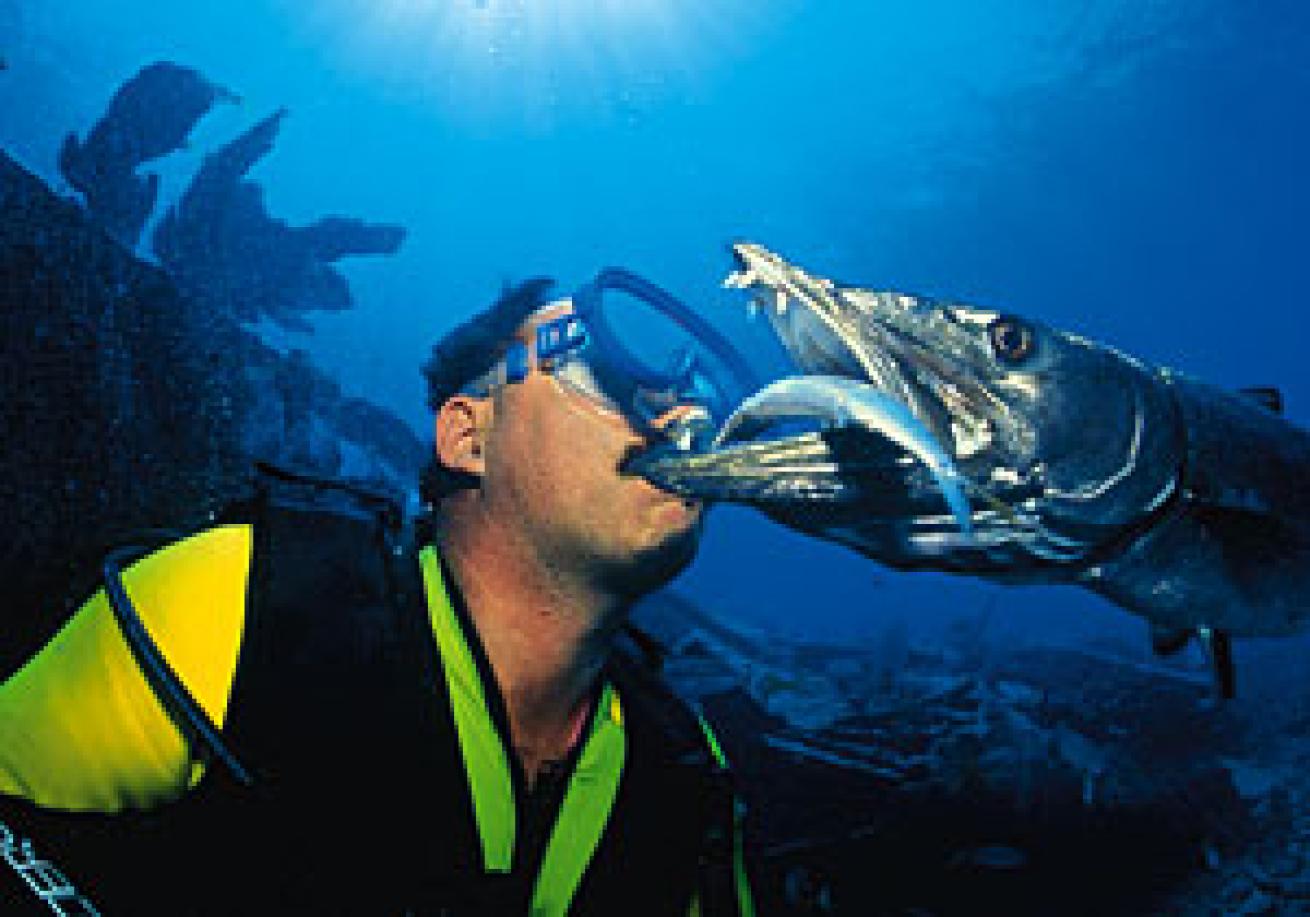
Captain Slate's Barracuda
This year, 2008, marks Capt. Spencer Slate's 30-year anniversary in Key Largo, running dive trips from his Atlantis Dive Center. I know this well because we came to town at almost the same time, and in those early years, I was a frequent guest on his dive boats as I built my image archive. One of the things I loved to shoot was his weekly "Creature Feature," where he'd go out to the City of Washington wreck, and in just 25 feet of water (plenty of light and plenty of time), he'd eccentrically feed the green moray eels and barracuda by inviting them to take a dead ballyhoo from his clenched teeth.
This barracuda in particular was a tough subject to shoot. These fish move very fast when they hit the bait, they are extremely reflective and there are a lot of other fish competing for the same piece of food. It all becomes frenetic and gets stirred up quickly, but Slate has a wonderful instinct for driving the action to my dome and, after repeated sessions, we knew each other's rhythms well. Slate would look at me to make sure my strobe was in position and I was ready. With a tiny nod of my head to acknowledge, he'd raise the ballyhoo to his lips, sheltering it from the swarming yellowtail until the barracuda was in striking range. Actually, I found if I got very close to the bite, the yellowtail wouldn't get in front of my lens because if they got too close to the strike, they might get eaten as well. So, I moved in ultra-close with a 180-degree lens, in this case a 13mm on a Nikonos RS. I was probably about 7 inches from the teeth of the barracuda. Slate was much closer, and even after all these years, he still has both lips.
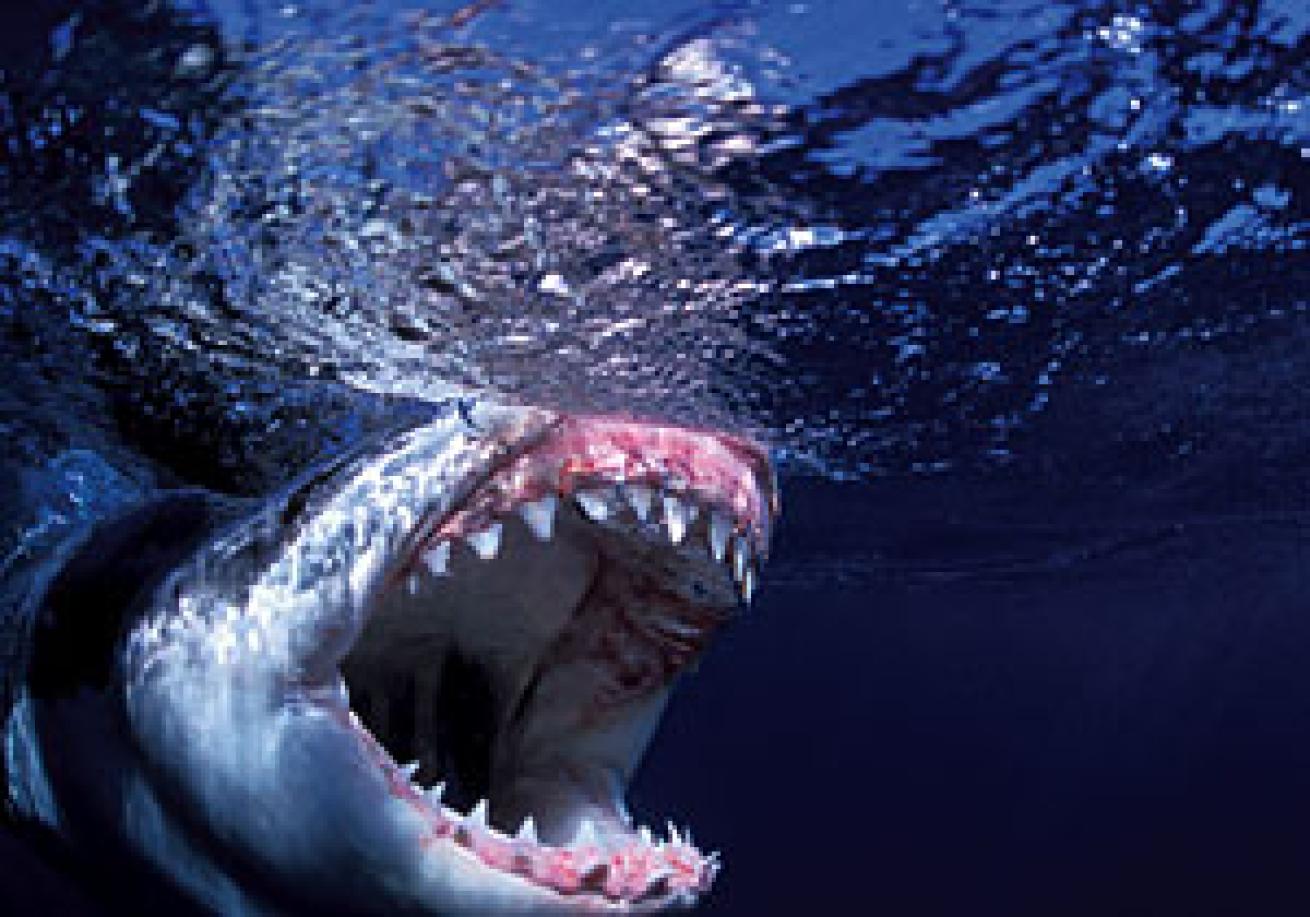
Great White Shark
There is no more impressive predator in the sea than the great white shark, and the quest for the classic shot of jaws agape and perfectly serrated teeth displayed has taken me to the three global hot spots for white sharking: Guadalupe, South Africa and South Australia. Usually, I'll shoot from behind the bars of a cage, but with the right shark and calm surface conditions, sometimes I can do better with a pole-mounted camera.
These days I have a very sophisticated polecam system (bottom right), with a tiny video camera replacing my optical viewfinder and feeding everything my lens sees to an external monitor, triggered by a remote control shutter release--all high-res digital, of course--but for this shot, back in the film days, my system was still pretty crude. We were at North Neptune Island, Australia, on the Calypso Star, and I had a Nikonos RS with a 13mm lens mounted at the end of the center section of my tripod. I had manually prefocused on the bait a foot away and the exposure was set to shutter speed priority--1/250th of a second to stop the action. Nikon's remote trigger release was used to take the shot, but the composition was random. Because of refraction, I couldn't tell exactly what the lens was seeing. My only hope was to get very close and fill the frame. At that point all I needed was a shark, near and gnarly, and fortunately this one obliged--for one pass only.
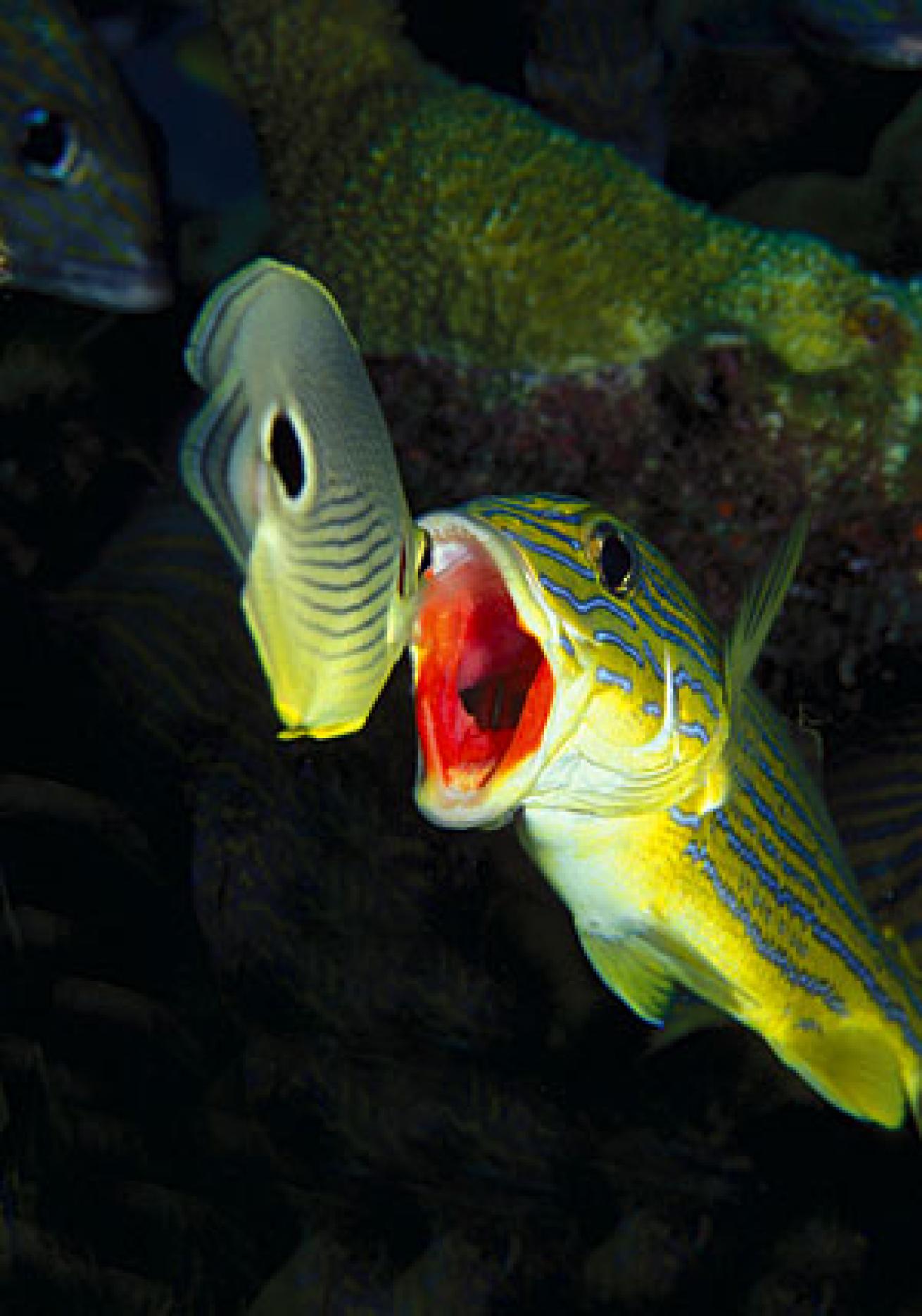
Grunt "Kiss"
Living in Key Largo, I get plenty of opportunities to photograph the ubiquitous blue-striped grunt, but with familiarity comes the challenge to capture the image differently or better than before. My favorite place to do so is a site called Snapper Ledge, not only for its massive populations of grunts, snapper and goatfish but also because of the unique behaviors that seem to go on there more commonly than at other sites. Here, the porkfish and four-eyed butterflyfish often approach the grunts, which in turn open their mouths wide for a cleaning.
I found the best tool for this action is a 100mm macro lens mounted on my full-frame digital SLR. By tracking the cleaner fish as they move into the school of grunts, it is not unusual to see one open its mouth. The trick is to have the strobes positioned and aperture set perfectly before entering the shoot zone. When the mouth opens, it won't be for long. Anticipating where the action will happen assures success
